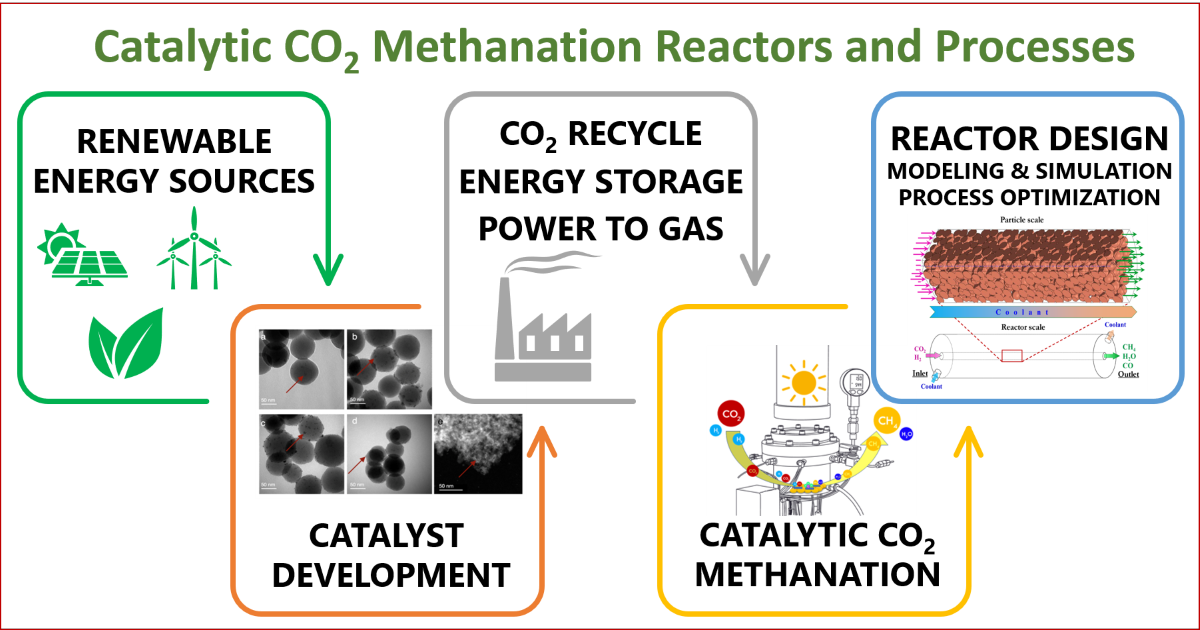Catalytic CO2 Methanation Reactors and Processes
A special issue of Catalysts (ISSN 2073-4344). This special issue belongs to the section "Catalytic Reaction Engineering".
Deadline for manuscript submissions: closed (20 December 2022) | Viewed by 24064

Special Issue Editors
Interests: multiphase flows; chemical engineering; computational fluid dynamics; multiscale modeling; high-performance computing; machine learning in CFD
Special Issues, Collections and Topics in MDPI journals
Special Issue Information
Dear Colleagues,
CO2 methanation plays an important role in balancing the time-variant supply and demand of electrical energy from intermittent nature renewable sources such as wind and solar.
Methane is easier to store and transport than electrical energy and has a good storage capacity combined with high charge/discharge periods. The excess energy from renewable sources can be converted to methane via catalytic CO2 methanation reactors. Commercial and environmental benefits have made CO2 methanation one of the most important research projects all over the world today.
Unlike biological methanation, catalytic or thermochemical CO2 methanation (CCM) operates at high temperatures between 200 and 550 °C and pressures up to 100 bar due to thermodynamic equilibrium. Therefore, CCM is characterized by a high production rate and methane selectivity. The reaction is highly exothermic, and proper heat management is necessary to avoid hot spots which are detrimental to catalyst performance.
To date, although great efforts have been made to investigate the reactor and process design for CCM, commercial CCM plants are still rare as commercial CCM requires a proper process design and reactors considering both economic feasibility and environmental regulation on a specific country.
Here, we aim to gather contributions from researchers and engineers to examine the issues of a flexible process and reactor design for CCM that is suitable for commercialization in many different countries.
Dr. Son Ich Ngo
Prof. Dr. Enrique García-Bordejé
Guest Editors
Manuscript Submission Information
Manuscripts should be submitted online at www.mdpi.com by registering and logging in to this website. Once you are registered, click here to go to the submission form. Manuscripts can be submitted until the deadline. All submissions that pass pre-check are peer-reviewed. Accepted papers will be published continuously in the journal (as soon as accepted) and will be listed together on the special issue website. Research articles, review articles as well as short communications are invited. For planned papers, a title and short abstract (about 100 words) can be sent to the Editorial Office for announcement on this website.
Submitted manuscripts should not have been published previously, nor be under consideration for publication elsewhere (except conference proceedings papers). All manuscripts are thoroughly refereed through a single-blind peer-review process. A guide for authors and other relevant information for submission of manuscripts is available on the Instructions for Authors page. Catalysts is an international peer-reviewed open access monthly journal published by MDPI.
Please visit the Instructions for Authors page before submitting a manuscript. The Article Processing Charge (APC) for publication in this open access journal is 2200 CHF (Swiss Francs). Submitted papers should be well formatted and use good English. Authors may use MDPI's English editing service prior to publication or during author revisions.
Keywords
- Catalytic CO2 methanation
- Modeling and simulation of catalytic CO2 methanation reactors
- Reactor design for CO2 methanation
- Power-to-gas
- Energy storage
Benefits of Publishing in a Special Issue
- Ease of navigation: Grouping papers by topic helps scholars navigate broad scope journals more efficiently.
- Greater discoverability: Special Issues support the reach and impact of scientific research. Articles in Special Issues are more discoverable and cited more frequently.
- Expansion of research network: Special Issues facilitate connections among authors, fostering scientific collaborations.
- External promotion: Articles in Special Issues are often promoted through the journal's social media, increasing their visibility.
- e-Book format: Special Issues with more than 10 articles can be published as dedicated e-books, ensuring wide and rapid dissemination.
Further information on MDPI's Special Issue polices can be found here.






